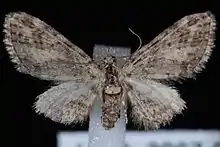Eupithecia maestosa
Eupithecia maestosa is a moth in the family Geometridae first described by George Duryea Hulst in 1896.[1][2] It is found in North America from extreme western Alberta west to Vancouver Island, north to northern British Columbia and south to Texas and California. The habitat consists of wooded and shrubby areas.
| Eupithecia maestosa | |
|---|---|
 | |
| Scientific classification | |
| Kingdom: | Animalia |
| Phylum: | Arthropoda |
| Class: | Insecta |
| Order: | Lepidoptera |
| Family: | Geometridae |
| Genus: | Eupithecia |
| Species: | E. maestosa |
| Binomial name | |
| Eupithecia maestosa (Hulst, 1896) | |
| Synonyms | |
| |
The wingspan is 17–21 mm. Adults are dark yellow brown and grey.[3] They are on wing nearly year round in California.[4]
References
- Yu, Dicky Sick Ki. "Eupithecia maestosa (Hulst 1896)". Home of Ichneumonoidea. Taxapad. Archived from the original on March 24, 2016.
- mothphotographersgroup
- "Species Page - Eupithecia maestosa". Entomology Collection. University of Alberta E.H. Strickland Entomological Museum. Archived from the original on November 2, 2019.
- Bug Guide
| Wikimedia Commons has media related to Eupithecia maestosa. |
| Wikispecies has information related to Eupithecia maestosa. |
This article is issued from Wikipedia. The text is licensed under Creative Commons - Attribution - Sharealike. Additional terms may apply for the media files.